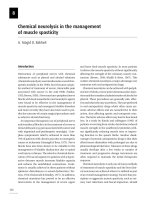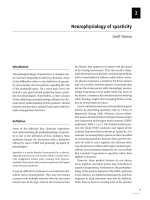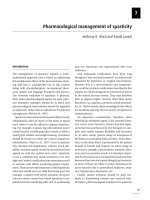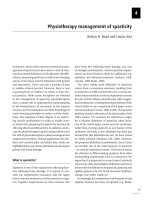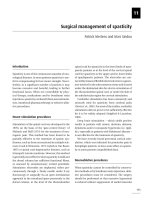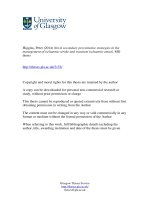Physiotherapy management of spasticity
Bạn đang xem bản rút gọn của tài liệu. Xem và tải ngay bản đầy đủ của tài liệu tại đây (614.08 KB, 20 trang )
4
Physiotherapy management of spasticity
Roslyn N. Boyd and Louise Ada
In the past, much of the controversy about the man-
agement of spasticity has been due to a lack of com-
monly accepted definitions of the disorder, the diffi-
culty in measuring spasticity as well as the changing
nature of the motor activity limitations with growth
and maturation. There was also a paucity of data
to validate clinical practice. However, there is now
a growing body of evidence on which to base clin-
ical practice. While many disciplines are involved
in the management of spasticity, physiotherapists
have a unique role in applying their understanding
of the biomechanics of movement to the analysis
of motor activity limitations and their knowledge of
motor learning principles to reduce activity limita-
tions. The emphasis of this chapter is on improv-
ing muscle performance in order to enable activ-
ity rather than preparing the patient for function by
affecting abnormal reflexactivity.Inaddition, wedis-
cuss the physiotherapist’s goal in using orthoses and
the role of physiotherapists in pharmacological and
surgical interventions. Clinical applications for chil-
dren with cerebral palsy and adults after stroke are
highlighted because these individuals are the largest
groups with brain damage.
What is spasticity?
Spasticity is one of the impairments affecting func-
tion following brain damage. It is typical to con-
sider the impairments associated with the upper
motor neurone syndrome as either positive or nega-
tive. Negative impairments are those features that
have been lost following brain damage (e.g. loss
of strength and dexterity), whereas positive impair-
ments are those features which are additional (e.g.
spasticity and abnormal postures) (Jackson, 1958;
Landau, 1980; Burke, 1988).
The most widely used definition of spasticity
comes from a consensus statement resulting from
a conference in 1980 and describes it as ‘a motor dis-
order characterized by a velocitydependent increase
in tonic stretch reflexes (muscle tone) with exagger-
ated tendon jerks, resulting from hyperreflexia of the
stretch reflex as one component of the upper motor
neuron syndrome’ (Lance,1980, p.485).This puts the
problem clearly in the realm of an abnormality of the
reflex system. It is common for clinicians to argue
for a broader definition of spasticity, often inclu-
sive of the whole upper motor neurone syndrome,
rather than viewing spasticity as one feature of the
syndrome. Recently, a new definition has been put
forward but this definition has not yet been tested
or widely adopted (Pandyan et al., 2005). However,
the proposed definition is problematic, since it does
not include one of the main features of spasticity
– its velocity-dependent nature. This feature assists
the clinician in differentiating spasticity from other
confounding impairments such as contracture. We
argue that it is important to accept Lance’s relatively
narrow but clear physiological definition and this is
in line with the definitions of spasticity, dystonia and
rigidity agreed on by the North American Taskforce
(Sanger et al., 2003) (Table 4.1).
Increasingly, the independence of the positiveand
negative features has been recognized (e.g. Burke,
79
80 Roslyn N. Boyd and Louise Ada
Table 4.1.
Term Definition
Spasticity A motor disorder characterized by a velocity-dependent increase in tonic stretch reflexes
(muscle tone) with exaggerated tendon jerks, resulting from hyperreflexia of the stretch reflex
as one component of the upper motor neurone syndrome (Lance, 1980, p. 485).
Hyperreflexia A greater than normal reflex response (e.g. the presence of reflex responses when a relaxed
muscle is stretched at the speed of normal movement).
Tone The resistance felt when moving a limb passively through range due to inertia and the
compliance of the tissues.
Hypertonia A greater than normal resistance felt when moving a limb passively through range.
Dystonia A movement disorder in which involuntary sustained or intermittent muscle contractions
cause twisting and repetitive movements, abnormal postures or both (Sanger et al., 2003).
Overactivity Excessive muscle activity for the requirements of the task.
Passive stiffness The force required to lengthen a muscle at rest (i.e. the slope of the force-displacement curve).
Active stiffness The force required to lengthen a muscle, which is active (i.e. the slope of the active
force-displacement curve).
Impairment Loss of body function or problem in body structure (WHO, 2001).
Activity limitation Difficulty in execution of a task or action (WHO, 2001).
Participation restriction Problems experienced in involvement in life situations in a societal role (WHO, 2001).
1988). Viewing the positive and negative impair-
mentsasseparatefeatures ofthesyndromewill affect
assessment and management procedures. Forexam-
ple,it is important toinitiallydifferentiatethe relative
contributions of the impairments so that interven-
tion specific to the problem can be instituted. Group-
ing all impairments seen following an upper motor
neurone lesion under one category, as a spastic ‘syn-
drome’ does not help this process.
How important a determinant of activity
limitations is spasticity?
If spasticity is only one of several impairments fol-
lowing brain damage, physiotherapists need to clar-
ify how spasticity affects the ability to move. Histor-
ically, spasticity was seen as the major determinant
of activity limitations. However, Landau (1974) ques-
tioned this assumption, and a variety of experiments
have since supported hisposition. First,experiments
eliminating spasticity in specific muscles after stroke
(McLellan, 1977) and in children with cerebral palsy
(Nathan, 1969; Neilson & McCaughey, 1982) did not
result in improved performance of that particu-
lar muscle. Second, studies examining the relation
between spasticity and muscle performance found
no correlation between them (Sahrmann & Norton,
1977; O’Dwyer et al., 1996). These experimental find-
ings resulted in dexterity being viewed as a sepa-
rate impairment rather than the result of spastic-
ity. However, these findings are often misinterpreted
as suggesting that spasticity either does not exist
or is never a problem. Severe spasticity will obvi-
ously limit everyday activities and restrict partici-
pation in society. Rather, the implication of these
findings is that reducing spasticity will not automat-
ically improve function and the abnormal negative
features require specific training.
Experiments on the nature of the abnormality
of the stretch reflex after brain damage may help
us to understand how spasticity can contribute to
Physiotherapy management of spasticity 81
activity limitations. Clinically, the picture of spastic-
ity is one of increased resistance to passive move-
ment of a relaxed muscle caused by abnormal reflex
activity. There is an assumption that this abnormal
reflex activity will be exaggerated when the person
attempts to move. However, there is growing evi-
dence that, rather than the picture of a small reflex
abnormality under relaxed conditions being exag-
gerated under active conditions, the reflex is not
modulated. That is, the reflex responses do not get
larger under active conditions. Lack of modulation
of the reflex has been found when studying pha-
sic stretch reflexes (Ibrahim et al., 1993) as well as
polysynaptic, tonic stretch reflexes (Ada et al., 1998;
Ibrahim et al., 1993). This paints a picture, not of an
abnormal ‘out-of-control’ reflex but of a reflex that
is not being modulated. Normally, the reflex is mod-
ulated up and down according to the requirements
of the task. In the presence of spasticity, the reflex is
‘on’ regardless of conditions.Perhaps the amount the
reflex is ‘on’ is the determining factor as to whether
spasticity interferes with movement control. A per-
son with an abnormal stretch reflex that is ‘on’ a
small amount will register as spastic when measured
clinically but the reflex response may not increase
with movement, thereby not interfering with func-
tion. This suggests that patients who are measured
as mildly to moderately spastic under passive condi-
tions are not necessarily hampered by this spasticity
during function. On the other hand, if the reflex is
always ‘on’ a large amount, even if the response does
not increase with effort, it will interfere with move-
ment. That is, moderate to severespasticity may con-
tribute to activity limitations by causing excessive
muscle contraction which resists lengthening of the
affected muscle during everyday actions.
Confusion between spasticity and other
impairments
The difficulty in assessing the contribution of differ-
ent impairments to activity limitations makes it pos-
sible for other impairments to be mislabeled as spas-
ticity. One of the major confusions is between the
neural and peripheral causes of hypertonia, a term
often used interchangeably with spasticity. ‘Hyper-
tonia’ refers to the excessive resistance, which may
be felt when the limb of a brain-damaged person is
moved passively. The resistance felt when a normal
limb is moved slowly through range is the result of
the inertia of the limb and the compliance of the soft
tissues (Katz & Rymer, 1989). Normally, there is no
contribution from reflex activity – that is, the mus-
cles are electrically silent (Burke, 1983). The increase
in resistance often felt after brain damage is usually
assumed to be the result of hyperreflexia – that is,
it is a neural problem, in line with Lance’s defini-
tion. However, the increased resistance may be the
result of a peripheral problem, such as the increase
in stiffness often associated with contracture. Ani-
mal studies into the muscle biology of contracture
have revealed that contracture is associated with
an increase in muscle stiffness due to a remodeling
of the connective tissue (e.g. Goldspink & Williams,
1990). Furthermore, the ability of a muscle with con-
tracture to produce an increase in the resistance
to passive movement in humans has been verified.
O’Dwyer et al. (1996) found that muscle stiffness can
be associated with muscle contracture, even in the
absence of hyperreflexia. The confusion is further
reinforcedbecause the oneofthe most commonclin-
ical measures of hypertonia – the Ashworth scale –
does not differentiate between neural and peripheral
causes of hypertonia. It is important, however, for
physiotherapists to be able to differentiate between
these two causes of hypertonia because the inter-
vention for muscle contracture is different than that
for spasticity. Figure 4.1 illustrates figuratively two
possible mechanisms of hypertonia.
Another possible confusion between motor
impairments is that between spasticity and vol-
untary muscle overactivity. When the person with
spasticity activates a muscle, thereby stretching the
muscle spindle and exciting the hyperactive stretch
reflex, this in turn causes the muscle to contract
excessively relative to the original neural input.
While spasticity is undoubtedly one cause of over-
activity exhibited by people with brain damage,
another may be lack of skill. Unskilled performance
82 Roslyn N. Boyd and Louise Ada
Figure 4.1. Two possible mechanisms of hypertonia following an upper motor neurone lesion. The solid arrows indicate
well-established mechanisms, while the open arrows indicate more hypothetical mechanisms. (With permission from
O’Dwyer & Ada 1996.)
is usually accompanied by excessive, unnecessary
muscleactivity(Basmajian, 1977;Basmajian& Blum-
menstein, 1980). Several studies have demonstrated
that an increase in skill is accompanied by a decrease
in muscle activity (Payton & Kelley, 1972; Payton,
1974; Hobart et al., 1975). It may be that some of the
motor behavior that clinicians have viewed as spas-
tic is the result of lack of skill. For example, Figure 4.2
illustrates an attempt by a person after stroke to lift
a glass off the table, but instead of the wrist radially
deviating, the elbow flexes. Behavior such as this is
often attributed to biceps spasticity. However, over-
activity in the biceps in this case is unlikely to be the
result of spasticity since, following feedback about
performance, the patient successfully lifts his or her
hand without any accompanying elbow flexion. In
a recent study (Canning et al., 2000), adults follow-
ing chronicstrokedemonstratedexcessive, unneces-
sary activity during the performance of a task which
was correlated with poor performance but not with
spasticity. Yet more confusion exists between spas-
ticity and other neurological impairments such as
dystonia and rigidity. It is important to differentiate
these impairments from each other since this will
have implications for assessment and intervention.
This has been made easier recently by the consensus
definitions put forward by the North American Task-
force (Sanger et al., 2003) (Table 4.1).
Effect of pathology and maturation
on spasticity
The operational definitions and relative importance
of spasticity areconfounded by the issue of how spas-
ticity affects growth and maturation in children with
spastic-type cerebral palsy. It is a common clinical
observation that muscle growth does not keep pace
with bone growth in young children with cerebral
palsy (Rang, 1990). It is assumed that decreased lon-
gitudinal growth of the muscle is caused by overac-
tivity due to spasticity. Animal models of spasticity
have demonstrated the lack of longitudinal growth
of the muscle relative to bone (Ziv et al., 1984). Fur-
thermore, normal longitudinal muscle growth has
been restored following intramuscular injections of
Botulinum toxin A (BoNT-A) to reduce spasticiy,
thereby allowing full muscle excursion (Cosgrove &
Graham, 1994). Human studies have supported the
notion that the muscle normally grows in response
to full muscle excursion (Koning et al., 1987).
Physiotherapy management of spasticity 83
(a)
(b)
Figure 4.2. (a) When this woman was asked to lift her hand off the table, she flexed her elbow. (b) However, when she
understood that elbow flexion should not take place, with practise, she lifted her hand by bending at the wrist only. (With
permission from Carr et al., 1995.)
84 Roslyn N. Boyd and Louise Ada
In addition, how muscles respond to casting to
lengthen muscles may vary with age. Animal stud-
ies have shown that the response of young muscle
to immobilization in a lengthened position differs to
thatofolder muscle (Tardieuet al.,1977a).Theyoung
muscle initially responds in a similar way to adult
muscle by the addition of sarcomeres. However, no
further addition of sarcomeres but a relative length-
ening of the muscle tendon in the young animal fol-
lows this. Although there should be some caution
in extrapolating evidence from the animal literature
to clinical practice, these findings may explain the
tendency for an overlengthened calf muscle tendon
and short gastrosoleus muscle belly frequently seen
after growth periods and after extended periods of
serial casting in children with cerebral palsy. Recent
ultrasounddatasupporttheshortnessofthereduced
fibre diameter in certain muscles (medial gastrocne-
mius) rather than reduced fibre length (Shortland
et al., 2002), which explains the differences in mus-
cle architecture of childrenwith cerebral palsy before
and after surgery (Shortland et al., 2004).
There can be an appreciable difference in the
peripheral components of hypertonia in a young
child with cerebral palsy (1 to 4 years) compared
with adolescents who have undergone their second
growth spurt. Clinically, younger children tend to
demonstrate overactivity, which leads to reduced
muscle excursion, while adolescents are more
likely to demonstrate contracture and weakness. In
addition, the development of contracture in certain
muscle groups may be faster according to the motor
distribution. In children with hemiplegia due to
cerebral palsy, it is often the calf muscles before the
hamstring muscles which develop reduced excur-
sion whereas in children with diplegia it is often
the hamstring and adductor muscles before the
calf muscles (Boyd & Graham, 1997). The concept
of the biological clock ticking faster in children
with cerebral palsy in certain muscles according to
motor type and aetiology has been proposed (Boyd
& Graham, 1997). On the other hand, there may be
a mechanical explanation. The child with cerebral
palsy who spends most of his or her time sitting
and crawling is likely to have shorter hamstring
muscles. Prediction of which muscles are ‘at risk’ of
shortening from observation of common patterns
of overactivity and increased muscle stiffness will
help in the prevention of muscle contracture.
The relative contribution of the positive and neg-
ative features in adults and children appears to dif-
fer due to the health condition. In stroke, prob-
lems of weakness and dexterity are more apparent
(Carr et al., 1995). In young children with cerebral
palsy, the positive features of velocity-dependent
hyperreflexia and inappropriate muscle overactiv-
ity lead to reduced muscle excursion and eventual
contracture (Rang, 1990; Cosgrove et al., 1994). By
adolescence, weakness and muscle contracture may
become greater problems.
Assessment of spasticity
An important component of the clinical manage-
ment of brain damage is careful assessment of the
contribution of various impairments to activity lim-
itations. Unfortunately, this is not an easy task. Spas-
ticityismost commonly measuredclinically byeither
grading the response of the tendon jerk while the
subject is relaxed (where an increased response is
reported as hyperreflexia) and/or grading the resis-
tance to passive movement while the subject is
relaxed (where increased resistance is reported as
hypertonia, e.g. Ashworth, 1964). Spasticity is most
commonly measuredin the laboratory bymovingthe
joint (mechanically or manually), either by repeated
oscillation (sinusoidal movement) or by a single
ramp movement and quantifying the EMG activity
in response to stretch (e.g. Neilson & Lance, 1978;
O’Dwyer et al., 1996b) and/or quantifying the resis-
tance to movement (e.g. Gottlieb et al., 1978; Rack
et al., 1984; Hufschmidt & Mauritz, 1985; Lehmann
et al., 1989; Corry et al., 1997).
The difficulty is that both the clinical and labo-
ratory measures of resistance to movement do not
differentiate whether the cause of the hypertonia
is neural or peripheral. The most valid measure of
spasticity is the use of EMG during passive stretch
of a muscle because the presence of stretch-evoked
muscle activity is the only way of ascertaining a
neural component. However, this is not a feasible
Physiotherapy management of spasticity 85
technique for clinical use. In one study, no rela-
tion was found between clinically measured phasic
stretch reflexes (tendon jerks) and laboratory mea-
suredtonic stretchreflexes(Vattanasilp &Ada,1999).
The lack of relationship between these two tests of
reflex activity can be explained by the fact that they
are measuring different components of the stretch
reflex response. The tendon jerk excites a phasic,
monosynaptic component of the stretch reflex in
response to a rapid stimulus. In contrast, sinusoidal
stretch in which the input is ongoing excites a tonic,
polysynaptic component of the stretch reflex. Fel-
lows et al. (1993) have previously pointed out that
the tendon jerk has limitations in providing a com-
plete picture of the pathological changes in reflex
responses following stroke.
While the Ashworth scale has been shown to
adequately measure resistance (Vattanasilp & Ada,
1999), it measures both the neural and peripheral
contributions to resistance without differentiating
their individual contributions. However, the Tardieu
scale (Tardieu et al., 1954, 1957; Held & Pierrot-
Deseilligny, 1969; Gracies et al., 2000) appears on the
face of it to be better at identifying a neural com-
ponent (Scholtes et al., 2006). By moving the limb at
different velocities, the response to stretch can be
more easily gauged since the stretch reflex responds
differentially to velocity. A recent study (Patrick &
Ada, 2006) indicates that the Tardieu scale is able to
identify the presence of spasticity after stroke more
effectively than the Ashworth scale in both an upper
and lower limb muscle. Not only was the Tardieu
scale able to identify the presence of spasticity, but it
was also able to differentiate it from the presence of
contracture. The velocity-dependent nature of the
stretch reflex means that contracture can be mea-
suredunder conditions in which hyperreflexiawill be
minimized. For example, by moving the limb slowly
so as not to excite hyperexcitable reflexes and hold-
ing the muscle in a lengthened position for a while so
as to dampen thereflex response, an accurate picture
of muscle length can be gained. In order to increase
reliability of the Tardieu scale, Boyd and Graham
(1999) proposed standardized positions and veloc-
ities under which the catch angle of muscles should
be tested in children with cerebral palsy (Fig. 4.3).
Studies of inter-rater reliability of the modified
Tardieu scale show acceptable reliability in the lower
limb in children with cerebral palsy (Fosang et al.,
2003), yet Mackey et al. (2004) reported poorer relia-
bility in the upper limb in children with hemiplegia.
Mackey highlighted the difficulties in standardizing
the velocity at which the limb is moved and the diffi-
culties in defining the angle of catch range (Mackey
et al., 2004). These differences in reliability highlight
the technical difficulties in standardizing a clinical
measure in the presence of varying limb pathology
intheupper and lowerlimbsinchildrenwithcerebral
palsy. Nevertheless,theangleof responseinthe lower
limb has been found to be more useful in detecting
changes in spasticity after intervention in children
with cerebral palsy (Lespargot et al.,1994; Boyd &
Graham,1999; Love et al., 2001).
In contrast, reliability has been reported as
poor to moderate in severely brain-damaged adults
(Mehrholz et al., 2005). Patrick and Ada (2006) found
that the level of muscle response to stretch was more
valid than the angle in adults after stroke. At this
stage, the Tardieu scale appears to be a useful tool,
which is better than the Ashworth scale, particularly
at differentiating spasticity from contracture.
Clinically, the most important measurement for
physiotherapists is at the level of activity limita-
tions – that is, the level at which impairments affect
the everyday life of the person with brain dam-
age. Spasticity is just one of the impairments which
affects function. The clinician needs to carefully
assess the relative contribution of the individual
impairments and how they impact on activity lim-
itations. In summary, in the clinic, muscle contrac-
ture and function can be assessed, and it is pos-
sible to gain some insight into the contribution of
spasticity versus contracture to increased muscle
stiffness.
Intervention
There is very little evidence of the efficacy of physio-
therapy interventions directed specifically at reduc-
ing or eliminating spasticity to guide clinical prac-
tice. The little evidence from randomized controlled
86 Roslyn N. Boyd and Louise Ada
(a) (b)
Figure 4.3. Modified Tardieu scale used in children with spastic-type cerebral palsy. (a) Ankle being moved into
dorsiflexion and (b) knee being moved into extension. R1 represents the angle of muscle response (catch) as the joint is
moved at the fastest velocity possible (Tardieu V3). R2 represents the angle of muscle response (end range) at the slowest
velocity possible (Tardieu V1). The difference between R1 and R2 will indicate the relative contribution of spasticity versus
contracture. A large difference between R1 and R2 indicates more spasticity whereas a small difference indicates more
contracture. The difference between R1 and R2 can be used over time as a measure of impairment in clinical trials and to
predict potential response to spasticity management.
trials or systematic reviews that exist is for an
immediate effect of short-term interventions. For
example, Gracies et al. (2000) applied dynamic lycra
splints for 3 hours to the arms of people after stroke
and found an immediate reduction in spasticity.
Likewise,Agerionoti et al. (1990) vibratedtheantago-
nist muscle and produced a reduction in spasticity of
the agonist muscle after stroke. Currently there is no
evidence to support a reduction in spasticity in chil-
dren with cerebral palsy with physiotherapy (Butler
& Darrah, 2001; Lannin et al., 2006). Because of this
paucity of information, clinicians need to identify
the contribution of spasticity to activity limitations
in order to plan effective management. For exam-
ple, in adults, spasticity early after stroke has been
found to contribute to contracture (Ada et al., 2006).
On the other hand, in children with cerebral palsy,
the impairments of overactivity, inappropriate mus-
cle force, adaptive soft tissue changes due to overac-
tivity and imbalances with growth are most evident
in younger children, whereas weakness and adap-
tive soft tissue changes due to non-use may become
increasingly evident in the teenage years. Interven-
tion needs to include training the patient to control
muscles for specific tasks while eliminating unnec-
essary muscle activity during motor performance as
well as maintaining soft tissue extensibility. It may
be necessary to apply pharmacological treatment to
dampen overactivity and reduce muscle stiffness, or
if contracture already exists, to lengthen muscles by
serial casting followed by training in these length-
ened ranges (Boyd & Graham, 1997). If the lack of
soft tissue extensibility is mostly contracture and/or
bony deformity it may be appropriate to collaborate
in surgical programs which will restore biomechan-
ical alignment and balance the soft tissue contrac-
tures (Gage, 1994; Gough et al., 2004). Where appro-
priate, orthoses may enable more practice to be
carried out with appropriate biomechanical align-
ment. All these options must be accompanied by

